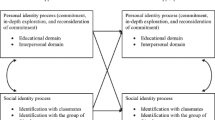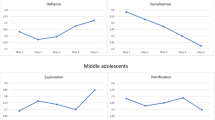Abstract
The purpose of this study was to develop a causal model to examine the ways in which familial and social variables influence identity development in late adolescence. Four hundred and ten 18-to 21-year-old male and female college students at a large Midwestern university completed a questionnaire assessing familial security, familial and social relations, and three dimensions of identity. The resulting causal models indicated that security in familial relations enhanced identity development directly, and also indirectly by initially enhancing adolescents' social confidence and degree of interpersonal affiliation. However, the pattern of interaction among these variables varied with sex and with the specific identity measure used. It is suggested that security in familial relations may provide the support for meaningful exploration and experimentation, and enhance aspects of adolescents' sociability, which, when taken together, may enhance the identity formation process.
Similar content being viewed by others
References
Adams, G. R., and Jones, R. M. (1983). Female adolescents' identity development: Age comparisons and perceived child-rearing experiences.Develop. Psychol. 19: 249–256.
Adams, G. R., Shea, J., and Fitch, S. A. (1979). Toward the development of an objective assessment of ego-identity status.J. Youth Adoles. 8: 223–237.
Ainsworth, M. D. S., and Ainsworth, L. S. (1958).Measuring Securing in Interpersonal Adjustment. University of Toronto Press, Toronto.
Ainsworth, M. D. S., Blehar, M. C., Waters, E., and Wall, S. (1978).Patterns of Attachment. Erlbaum, Hillsdale, NJ.
Allen, J. G. (1976). Identity formation in late-adolescent women. Unpublished doctoral dissertation, City University of New York.
Arend, R., Gove, F. L., and Sroufe, L. A. (1979). Continuity of individual adaptation from infancy to kindergarten: A predictive study of ego-resiliency and curiousity in preschoolers.Child Develop. 53: 1447–1460.
Bell, N. J., Avery, A. W., Jenkins, D., Feld, J., and Schoenrock, C. J. (1985). Family relationships and social competence during late adolescence.J. Youth Adoles. 14: 109–119.
Berndt, T. J. (1982). The features and effects of friendship in early adolescence.Child Develop. 53: 1447–1460.
Bowlby, J. (1969).Attachment and Loss. Basic Books, New York.
Brahms, J. S. (1978). The linkage between sexual and aggressive motivation in adolescence as related to psychosocial development. Unpublished master's thesis, Michigan State University.
Constantinople, A. (1969). An Eriksonian measure of personality development among college students.Develop. Psychol. 1: 357–372.
Damon, W. (1983).Social and Personality Development. Norton, New York.
Douvan, E., and Adelson, J. (1966).The Adolescent Experience. Wiley, New York.
Easterbrook, M. A., and Lamb, M. E. (1979). The relationship between quality of infant-mother attachment and infant competence in initial encounters with peers.Child Develop. 50: 380–387.
Erikson, E. H. (1959).Identity and the Life Cycle. International Universities Press, New York.
Erikson, E. H. (1968).Identity: Youth and Crisis. Norton, New York.
Fitts, W. (1965).Tennesse Self-Concept Scale. Counselor Recordings and Tests, Nashville, TN.
Gilligan, G. (1982).In a Different Voice. Harvard University Press, Cambridge, MA.
Gold, M., and Yanof, D. S. (1985). Mothers, daughters and girlfriends.J. Personal. Social Psychol. 49: 654–659.
Grotevant, H. D. (1983). The contribution of the family to the facilitation of identity formation in early adolescence.J. Early Adoles. 3: 225–237.
Grotevent, H. D. (1986). Individuation in family relationships: A perspective on individual differences in the development of identity and role-taking skill in adolescence.Hum. Develop. 29: 82–100.
Grotevant, H. D., and Cooper, C. R. (1985). Patterns of interaction in family relationships and the development of identity exploration in adolescence.Child Develop. 56: 415–428.
Grotevant, H. D., Thorbecke, W., and Meyer, M. L. (1982). An extension of Marcia's Identity Status Interview into the interpersonal domain.J. Youth Adoles. 11: 33–47.
Hartup, W. W. (1979). The social worlds of childhood.Am. Psychol. 34: 944–950.
Hartup, W. W. (1983). The peer system. In Mussen, P. H. (Ed.-in-chief) and Hetherington, E. M. (Ed.), Carmichael's Manual of Child Psychology (4th ed., Vol. 4). Wiley, New York.
Hodgson, J. W., and Fischer, J. L. (1979). Sex differences in identity and intimacy development in college youth.J. Youth Adoles. 8: 37–50.
Hunter, J. E. (1983). Sampling error in path analysis. Unpublished manuscript, Michigan State University.
Hunter, J. E., and Gerbing, D. W. (1982). Unidimensional measurement, second order factor analysis, and casual models.Res. Organiz. Behav. 4: 267–320.
Hunter, J. E., Cohen, S. H., and Nicol, T. S. (1982). PACKAGE. Unpublished manuscript, Michigan State University.
Jackson, D. N. (1967).Personality Research Form. Research Psychologists Press, Inc., Goshen, NY.
Jordan, D. (1970). Parental antecedents oof ego identity formation. Unpublished master's thesis, State University of New York at Buffalo.
Jordan, D. (1971). Parental antecedents and personality characteristics of ego-identity statuses. Unpublished doctoral dissertation. State University of New York at Buffalo.
Joselson, R. (1980). Ego development in adolescence. In Adelson, J. (Ed.),Handbook of Adolescent Psychology. Wiley, New York.
Kamptner, N. L. (1984). Attachment and individuation in late adolescence. Doctoral dissertation, Michigan State University.
LaVoie, J. C., (1976). Ego-identity formation in middle adolescence.J. Youth Adoles. 5: 371–385.
Lieberman, A. F. (1977). Preschoolers' competence with a peer: Relations with attachment and peer experience.Child Develop. 48: 1277–1287.
Lemon, B., Bengston, V., and Peterson, J. (1972). An exploration of the activity theory of aging: Activity types and life satisfaction among in-movers to a retirement community.J. Gerontol. 27: 511–523.
Marcia, J. E. (1980). Identity in adolescence. In Adelson, J. (Ed.),Handbook of Adolescent Psychology. Wiley, New York.
Marcia, J. E. (1983). Some directions for the investigation of ego development in early adolescence.J. Early Adoles. 3: 215–224.
Matteson, D. R. (1974). Allienation vs. exploration and commitment: Personality and family correlates of adolescent identity statuses. Report for the Project for Youth Research. Royal Danish School of Educational Studies, Copenhagen.
McKinney, J. P., Fitzgerald, H. E., and Strommen, E. A. (1982).Development Psychology: The Adolescent and Young Adult. Dorsey Press, Homewood, IL.
Neuber, K. A. and Genthner, R. W. (1977). The relationship between ego-identity, personal responsibility, and facultative communication.J. Psychol. 95: 1145–49.
Olson, D. H., Bell, R., and Portner, J. (1978). Family adaptibility and cohesion evaluation scales (FACES). Unpublished manuscript.
Orlofsky, J. L., Marcia, J. E., and Lesser, I. M. (1973). Ego identgity status and the intimacy versus isolation crisis of young adulthood.J. Personal. Social Psychol. 27: 211–219.
Pastor, D. L. (1981). The quanity of mother-infant attachment and its relationship to toddlers' sociability with peers.Develop. Psychol. 17: 326–335.
Schutz, W. F. (1978).The FIRO Awareness Scales Manual. Consulting Psychologists Press, Palo Alto, CA.
Siegel, O. (1982). Personality development in adolescence. In Wolman, B. (Ed.),Handbook of Development Psychology. Preontice-Hall, Englewood Cliffs, NJ.
Smart, L. S. (1978). Parents, Peers, and the quest for identity. In Smart, M. S., Smart, R. C., and Smart, L. S. (Eds.),Development and Relationships. Macmillan, New York.
Smith, R. S., and Smith, A. R. (1976). Attachment and educational investment of adolescence.Adolescence 11: 349–357.
Sroufe, L. A. (1978). Attachment and the roots of competence.Human Nature 1: 50–59.
Thorbecke, W., and Grotevant, H. D. (1982). Gender differences in adolescent interpersonal identity formation.J. Youth Adoles. 11: 479–492.
Waters, E., Wippman, J., and Sroufe, L. A. (1979). Attachment, positive affect, and competence in the peer group: Two studies in construct validation.Child Develop. 50: 821–829.
Author information
Authors and Affiliations
Additional information
Received Ph.D. in Psychology from Michigan State University. Current research interest is identity development in adolescence and adulthood.
Rights and permissions
About this article
Cite this article
Kamptner, N.L. Identity development in late adolescence: Causal modeling of social and familial influences. J Youth Adolescence 17, 493–514 (1988). https://doi.org/10.1007/BF01537827
Received:
Accepted:
Issue Date:
DOI: https://doi.org/10.1007/BF01537827




